Online teachers from all around the world have the worry that their accent will hold them back. This is a genuine concern because at The Really Great Teacher Company, thousands of applicants were unsuccessful due to accent alone.
Platforms want "neutral" American or Canadian voices, and every recruiter thinks: Is this accent easy enough for kids to follow?
The truth? You just need to fix 5-8 specific sounds, and suddenly you're "neutral enough." This guide shows you exactly which sounds to adjust, how to practice them, and when to stop obsessing over perfection.
Why Accent Matters in ESL Teaching
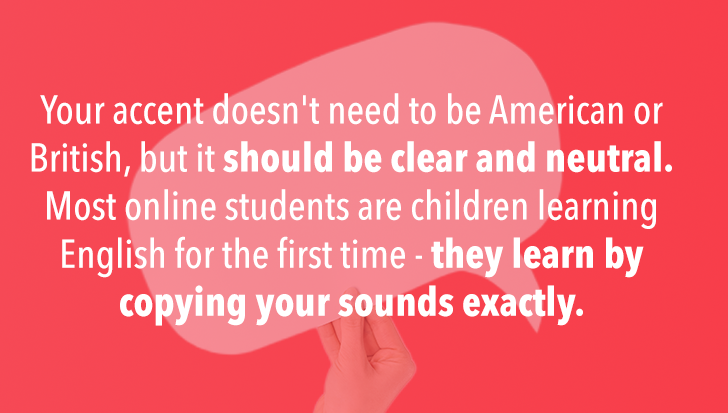
Picture this: A 6-year-old in Shanghai trying to copy your pronunciation of "three." If it sounds like "tree" or "free," they'll write it wrong on every test. That's why accent matters—not perfection, but clarity.
Schools in Asia splash US and UK flags across their ads, promising "native English speakers." When sheep slips out as ship in your demo, parents complain, and schools lose customers.
Your accent doesn't need to be American or British, but it should be clear and neutral. Most online students are children learning English for the first time - they learn by copying your sounds exactly.
That's why hundreds of applicants are turned down due to accent every month—not because they aren't qualified, but because their speech isn't always easy to understand by ESL students. Recruiters screen hard for clarity because it directly impacts student outcomes.
"Learn to soften strong sounds, slow down, and aim for clarity."
What is a Neutral Accent?
When companies say, "neutral accent," they mean speech without strong regional markers. Think TV Presenter:
- American = CNN anchor. No Southern drawl or Boston "r"-dropping.
- British = BBC presenter. Crisp. No heavy Cockney or Scottish accents.
These voices dominate TOEFL, IELTS, and language apps — what parents expect when they see those flags on school websites.
Your South African, or European, or South American accent isn't inferior. But recruiters listen for sounds that match what students hear in their learning apps. If your accent creates confusion during phonics lessons, you won't get hired.
It might not seem fair, but it's an assessment everyone needs to pass. If you've been denied an interview several times despite being qualified and experienced, your accent is likely the reason. Time to work on it.
How to Tell If Your Accent Is a Problem
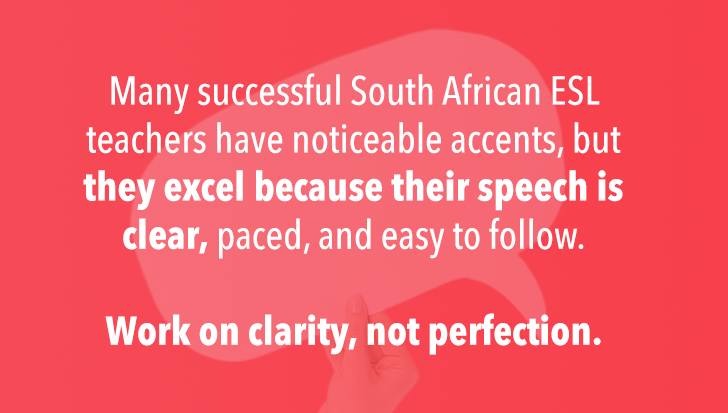
How would you know if your accent needs work? Here are the clearest signs:
- Failed applications pile up. If you're repeatedly rejected after voice screenings despite strong qualifications, your accent is likely the issue.
- Your Recordings Reveal Issues. Record yourself teaching and play it back. Do you sound significantly different from English YouTube teachers? Notice choppy rhythm or unclear vowels? That's what interviewers hear.
- Students Copy Your Errors. When learners can't distinguish "hit" from "heat" after your modeling, your pronunciation will affect their learning.
- You Dodge Certain Sounds. Avoiding words with "th" or "r" sounds in lessons means you know there's a problem.
- People Ask You to Repeat Yourself. In everyday English conversations, frequent "Sorry, what?" responses indicate a comprehension problem. If Siri or Google consistently misunderstands you, students will, too.
Many successful online teachers have noticeable accents, but they excel because their speech is clear, paced, and easy to follow. Work on clarity, not perfection.
How to Improve Your Teaching Accent
Work on building a "teaching voice" that makes you easier to understand, like actors who can switch between accents for different roles.
1) Get Clear on Your "Why"
Before diving into techniques, establish why you're doing this.
- Is it about getting hired faster?
- Earning in dollars?
- Working from home?
- Helping kids around the world?
Whatever your reason is, write it down. Your motivation will sustain you through the months of practice ahead.
Now take it a step further. Swap vague goals like "fix my accent" for something specific:
"Speak clearly enough to teach American Phonics in the next 6 months."
This clarity gives you a focus, a timeline. Post both your "why" and your goal where you'll see them daily. When motivation dips, your "why" pulls you through.
2) Challenging English Sounds for Non-native Speakers
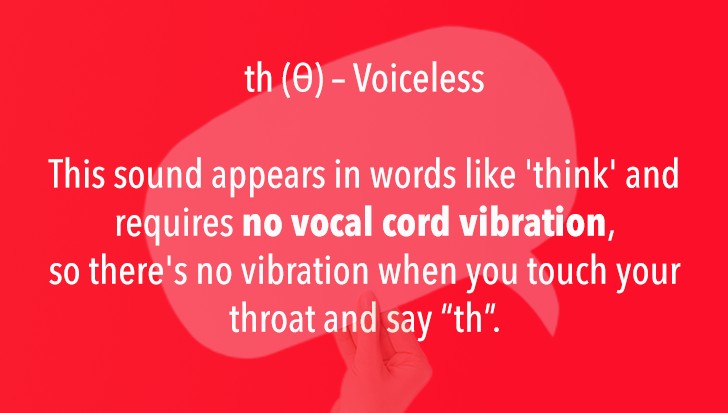
Non-native English speakers often struggle with certain sounds due to phonetic differences between their home and second languages. Pick one target a week, perfect it, then move on. Here's how to fix them:
A) The "TH" Sounds (/θ/ and /ð/)
For example, the Afrikaans language lacks these sounds entirely and often substitute:
- Voiceless "th" with "f" (think → fink)
- Voiced "th" with "d" (this → dis)
Pronunciation Technique
"Th" requires placing your tongue between your teeth and pushing air through the gap. "f" and "d" require you to keep your tongue behind your teeth – top or bottom.
th (θ) – Voiceless
This sound appears in words like 'think' and requires no vocal cord vibration, so there's no vibration when you touch your throat and say "th".
- Thank
- Mouth
- Fourth
th (ð) - Voiced
The "th" sound in words like 'that' uses your vocal cords, creating a vibration that you can feel when you touch your throat.
- Mother
- Brother
- Smooth
Drills:
Visual Aid: Use a mirror to check your tongue placement - you should see the tip extending slightly between your teeth.
Tongue-twister: "The three thieves thought thirty-three thoughts."
Minimal Pairs: Practice contrasting sounds to train your ear and mouth:
- think/sink
- thong/tong
- thank/tank
- thirty/dirty
It may feel funny but over-enunciate "th" until it's second nature. This small change makes a huge difference!
B) Open "Cat"/æ/ (Raised to "ket")
Certain dialects often raise /æ/ toward /e/: cat → ket. This confuses students instantly — they can't match the sound to the spelling.
English Short A:
American Short A:
Pronunciation Technique
- Drop your jaw two finger-widths.
- Tongue low-front; cheeks stretch.
- Hold caaaat for a full second, then release.
- Also, notice the difference between the American and English short A sounds.
Drills
- Word List: cat, hat, back, dance, grass.
- Minimal Pairs: bad/bed, pat/pet, cap/kept.
- Tongue Twisters: "The black bag had a snagged tag."
- Record Yourself: Read "The Cat in the Hat" by Dr. Seuss and compare it to any children's audiobook sample (they exaggerate vowels nicely).
C) W vs V Sounds
On the other hand, German teachers often turn 'w' into 'v' (wine → vine). English hears that as two totally different words, so let's lock in the right mouth shape.
/w/ is made with rounded lips, and /v/ is produced with the top teeth touching the bottom lip.
How to Pronounce W vs V
| Sound | Lips | Teeth | Voice | Example |
|---|---|---|---|---|
| W | Small “O,” lips round | Never touch teeth | Smooth, no buzz | woo, wine |
| V | Top teeth on bottom lip | Light contact | Throat buzzes | vine, very |
Drills
- Mirror Check – say wow. See a perfect circle, zero teeth.
- Lip-switch Test – say victory then wicked; feel teeth drop away on the W.
- Minimal Pairs – wine/vine, west/vest, we/vee, went/vent. Record->play back.
- Sentence Sprint – "We will visit the west vineyard."
D) Vowel Distinctions
English has more vowel sounds, so some sounds blur together. Focus on the high-impact pairs below to bring your accent in line:
1. Short /ɪ/ vs Long /iː/
- Minimal Pairs: bit / beat, sit / seat, live / leave
- Feel it:
/ɪ/ (bit) – tongue high-front but relaxed, jaw barely drops.
/iː/ (beat) – lips spread wider, tongue tenser, sound held a hair longer.
- Quick Drill Sentence: "He bit the beat note by mistake." Record—listen for length.
2. Short /e/ vs Open /æ/
- Minimal Pairs: bed / bad, pen / pan, met / mat
- Feel it:
/e/ (bed) – mid-jaw, tongue mid-front.
/æ/ (bad) – jaw drops two finger-widths, tongue low-front. Think "caaat."
- Quick Drill Sentence: "Dan met a mad man." Exaggerate æ, then dial it back.
5-Minute Practice Loop
- Mirror Check: watch jaw height switch between each pair.
- Slow → Fast Reps: repeat each pair three times, speeding up while keeping contrast.
- Voice-to-Text Test: Use Google or Word to transcribe your minimal pairs, and see if 'beat' appears instead of 'bit'.
E) The "Kit-Bit" Split
Another South African English example, is that it does something most other English accents doesn't: it splits the usual short-i (/ɪ/) sound into two flavors.
| Word Pair | General American | Common SA English |
|---|---|---|
| kit | /kɪt/ | /kɪt/ (stays /ɪ/) |
| bit | /bɪt/ | /bət/ (slides to schwa /ə/) |
Notice how kit keeps the high, tight /ɪ/, while bit relaxes into an "uh" sound. That's the kit-bit split.
Why It Happens
It changes /ɪ/ to a central schwa /ə/ except in a few spots:
- After Velars: kiss, gift
- After /h/: hit, hip
- Word-Initial: inch, if
- Before /ʃ/: fish, wish
Everywhere else—like bit, pick, dinner—/ɪ/ slides to /ə/.
Why Recruiters Notice
Textbooks, phonics apps, and TOEFL clips—all use the crisp /ɪ/. When you say bət for bit, kids copy you, and spelling-sound connection break.
Quick Fix Drills
1. Minimal Pairs
- bit–but
/bɪt/vs/bʌt/ - ship–sheep
/ʃɪp/vs/ʃiːp/ - Record, listen—can you hear the difference?
/ɪ/: lips relaxed, tongue high front./e/: jaw looser, tongue mid-central.- Watch your mouth shape switch.
- bit, sit, pick, milk, prince, busy
- Say them slowly, then at normal speed without letting them drift to
/e/.
2. Mirror Check
3. Target Words
Master these sounds and you'll sound instantly clearer to recruiters.
F) Z vs S — Keep the Buzz
Some languages turn /z/ into /s/: zebra → sebra. English hears two different sounds, so we need to add the vibration.
Voiced vs Voiceless: /s/ vs /z/
| Sound | Throat | Airflow | Example |
|---|---|---|---|
| /s/ | Silent | Just air | sip, snake, ice |
| /z/ | Vibrates | Air + voice | zip, zebra, eyes |
Quick Technique
- Hand-on-Throat Test: Say sip (no buzz) → zip (feel vibration).
- Hold the Z:Stretch zzzz for two seconds; keep it steady.
- Same Mouth Shape: Tongue behind top teeth for both sounds; only voicing changes.
Drills
- Minimal Pairs – zeal/seal, zipper/sipper, prize/price, cozy/cosy.
- Tongue Twisters – "The zany zebra played jazzy music." Emphasize each Z.
Ten focused reps a day and your Z will keep its buzz while your S stays hissy—exactly what recruiters (and students) need to hear.
G) Consonant Clusters
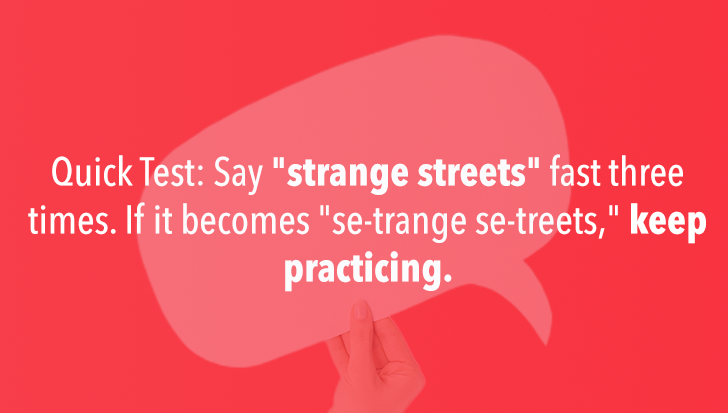
Other languages insert helper vowels into English consonant clusters. (school → se-cool or spring → se-pring). Native speakers hear these extra syllables immediately. Your goal: slide through the whole cluster as one sound—no helper vowel included.
Common Problem Clusters
| Cluster | Mispronunciation | Target Sound | Example Words |
|---|---|---|---|
| SCH | se-cool | school | school, schedule, scheme |
| SPR | se-pring | spring | spring, spread, spray |
| STR | se-treet | street | street, strong, strange |
| SCR | se-cream | scream | scream, scratch, script |
| SPL | se-plit | split | split, splash, splendid |
Pronunciation Technique
- Start Silent - Position your mouth for the whole cluster before making any sound
- Blend Forward - Move smoothly from S directly into the next consonant(s)
- No Vowel Space - Your tongue/lips should transition without creating room for extra sounds.
Progressive Drills
- Freeze-Frame Practice – Say "sssss" then freeze. Add "chool" without breaking: "sssschool"
- Speed Building – Start ultra-slow: "s...c...h...ool" → "sch...ool" → "school"
- Cluster Chains – "I'll splash in the school's spring sports schedule"
- Record & Compare – Record "the street near school" – any extra syllables?
Quick Test: Say "strange streets" fast three times. If it becomes "se-trange se-treets," keep practicing.
H) The American "R" Sound
Some accents are non-rhotic—where the R at the end of words or before consonants may be dropped or softened (water → wata). In American English, every written R is voiced, and it's made without touching the teeth or the roof of the mouth.
Pronunciation Technique
- Tongue Position: Lift the middle of the tongue; tip pulls back slightly but never touches anything.
- No "Trapped" R – If it sounds muffled, you've yanked the tip too far back. Slide it forward until the sound "flows."
- Lip Flare: – Create a tiny gap between lips and gums (think small bird-beak). Corners stay relaxed.
- Ending -ER: is a quick, unstressed /ɚ/: teacher, brother, faster—lips may barely move, but the tongue position stays the same.
- R Vowel ≠ Two Sounds: In words like bird, first, hurt, the "er" is just one long /ɝ/—don't add an extra schwa.
Practice progression:
- Start With the "er" Sound Alone: er
- Add Initial R: red, run, right
- Practice Middle R: very, caring, parent
- Master Final R: teacher, better, car
- Tackle R blends: try, brown, green
Drills
- Tongue-Twister: "Round and round the rugged rock the ragged rascal ran."
- Minimal Pairs: car/cah, four/faw, earn/un.
- Linking Practice: Chain words: far-away → faraway, better-off → betteroff—keep the R alive between words.
It may feel odd at first, but with repetition, it becomes natural. Rhoticity instantly makes your speech sound more American.
3) Choose Your Target Dialect: American vs. British English
Online schools want consistency in your pronunciation. Mixing accents confuses students and flags recruiters.
Which Accent?
American English dominates the online ESL market, particularly in Asian markets, but British English has strong demand in European and Middle Eastern contexts. Choose one and master it.
Key Accent Differences:
| American English | British English | |
|---|---|---|
| Middle T | Flaps to a soft D: wa-der, la-der | Stays crisp: wa-ter, la-ter |
| Final R | Always pronounced: car, teacher | Often dropped: cah, teach-a |
| Intonation | Flatter, level pitch | More pitch rise-falls |
| Lexicon | apartment, candy, fries | flat, sweets, chips |
Commit for 90 Days
- Media Immersion. Switch your YouTube, podcasts, and Netflix to the accent you picked.
- Word List Guardrail. Keep a running doc of "my-accent words" and review before every lesson.
- One-Accent Drills Only. Mimic news anchors or audiobook narrators from that region.
Lock in one accent, and your speech will sound intentional, not a hybrid mash-up.
4) Intonation & Stress — The Rhythm of English
English is a stress-timed language: some syllables stretch, others shrink - boom-tap-tap. Americans hit certain syllables hard —BA-na-na, OF-fice— and let the rest glide. Many other accents are syllable-timed, giving each syllable equal duration, which flattens the rhythm. Learn which syllables to hit, and your English will instantly sound more native.
Quick Check: Say "about". Native rhythm = a-BOUT ( ↑ pitch, longer).
Say about again with both parts equal—hear the difference?1. Word-Stress
English words aren't spoken at equal volume. One syllable gets the main hit (primary stress); in longer words, a second syllable may get a smaller bump (secondary stress).
| Word length | Where the boom usually lands | Sample words (stressed part in CAPS) |
|---|---|---|
| 2 syllables | 1st syllable | TEA-cher • STU-dent |
| 3 syllables | 1st syllable | WON-der-ful • IN-ter-est-ing |
| Rule-breakers | learn by ear | com-PU-ter • ba-NA-na |
Primary stress = loudest, longest, higher pitch.
Secondary stress = lighter bump in very long words.
Example with both levels: em-BAR-rass-ment (BAR = primary, EM = secondary).
Drill:
Clap on the bold syllable: BA-na-na, COM-fort-able.
2. Sentence-Stress Formula
Think of a sentence as a rhythm line: CONTENT words land on the beat; function words fade into the background.
| Word type | Examples | What to do |
|---|---|---|
| Content (carry meaning) | nouns, main verbs, adjectives, adverbs | say them LOUDER, LONGER, and a shade higher in pitch |
| Function (glue) | a, the, to, of, can, is, in | Keep them quick and quiet |
"I WANT to TEACH ENGlish onLINE."
Change the stress, change the meaning:
- “I WANT to teach …” (desire)
- “I want to TEACH …” (not learn)
- “I want to teach ENGlish …” (not math)
3. Intonation Patterns— Map the Pitch
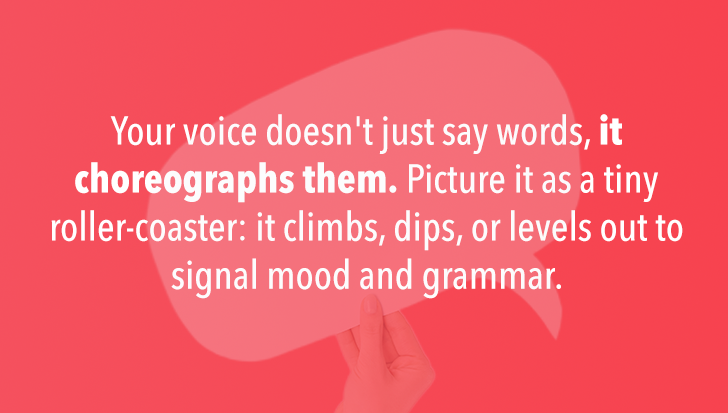
Your voice doesn't just say words, it choreographs them. Picture it as a tiny roller-coaster: it climbs, dips, or levels out to signal mood and grammar. Excited or playful? Your pitch rises and bounces. Serious or sad? Keep it flat and let the ends fall.
| Pitch shape | Teacher demo line | |
|---|---|---|
| Statement | Fall ↘ | “That’s cor-RECT.” ↘ |
| Yes/No question | Rise ↗ | “Can you see it?” ↗ |
| WH-question | Fall ↘ | “What does this mean?” ↘ |
| List | Rise, rise … fall ↗ ↗ ↘ | “We need a pen, book, and paper.” |
Pitch patterns act like invisible punctuation marks, helping listeners distinguish between questions, statements, and emotional attitudes.
Five Minute Intonation Practice Loop
- Clap-tap: Read a paragraph; clap on stressed words, tap on unstressed.
- Rubber-band Stress – Hook a band between your thumbs. Stretch on the stressed syllable, release on the weak.
- 10-sec Shadow – Grab an ESL demo clip. Play 10s, speak with it, rewind, repeat until your pitch and stress match.
- Question Drill – Fire off: “Can you hear me?” ↗ “Where are you from?” ↘
Lock these drills, and the "boom-tap-tap" feel becomes automatic—exactly what your students (and hiring managers) are listening for.
5) Shadow Native Speakers
When shadowing, you repeat what someone says with as little delay as possible.
It's not "repeat after me" but "speak along with me". Your goal is to speak in sync with a video in real-time, matching the speaker's pace, intonation, and pronunciation as closely as possible. Do it daily, and muscle memory takes over.
How to Practice Shadowing:
- Pick a Clip: Play a news report, TED Talk, or whatever fits your chosen accent.
- Turn on Annotations: Speak simultaneously with them, matching rhythm, pitch, and mouth movements.
- Can't Keep Up? Rewind 5 seconds and shadow again until it feels automatic. Don't worry about understanding every word—focus on mimicking the sounds.
- Record & Compare: One take with the native speaker, one solo. Spot the gaps: fix on the next loop.
Pro Tip: Pull up ESL demo lessons on YouTube. They mirror the pace and wording you'll use with kids.
6) Flip your Inner Monologue to English
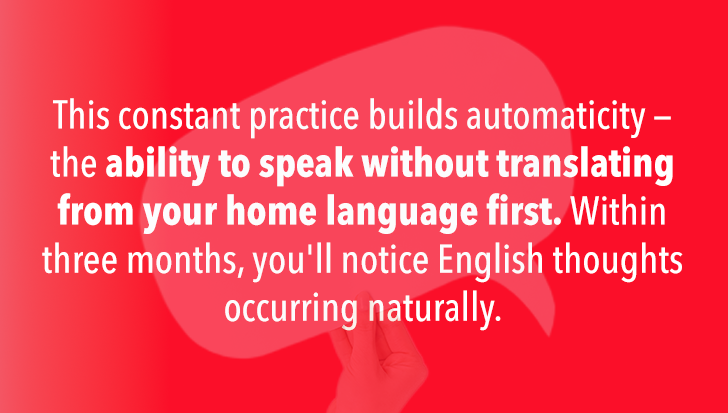
If you're awake, your inner voice speaks in English. It seems extreme, but will accelerate progress dramatically. Start with specific contexts:
| Trigger | What to Say | |
|---|---|---|
| Morning routine | Narrate your actions | “I’m brushing my teeth. Now I'm making coffee. The water is boiling.” |
| On the road | Describe what you see | “That’s a blue Toyota. The traffic lights are turning yellow. I should take the next left.” |
This constant practice builds automaticity—the ability to speak without translating from your home language first. Within three months, you'll notice English thoughts occurring naturally.
7) Record & Review—Your DIY Progress Tracker
Your smartphone is your most powerful accent coach. Self-recording forces you to hear what others hear—the first step to real change. Most people avoid this because it feels awkward, but it's the fastest way to spot patterns you can't catch while speaking.
Daily Micro-Check (5 minutes)
Read one page of a children's book, then play the matching audiobook. Any slip in rhythm, vowels, or clarity will stand out. Ask yourself: Would a six-year-old in China catch every word?
If not, jot the fixes in your pronunciation journal. This daily habit builds awareness without overwhelming you.
Weekly Deep Dive (15 minutes)
Record four short clips every week. Keep them brief — quality over quantity.
| Track | What to record | Length |
|---|---|---|
| A. Intro | 2-min self-introduction | 2:00 |
| B. Reading | One news paragraph | 1:00 |
| C. Off-the-cuff | Random topic rant | 1:30 |
| D. Mini-lesson | Teach a grammar point | 2:00 |
Listen Back Immediately. Flag any dropped R's, blurred vowels, or flat intonation. Write specific fixes in your journal: "Work on 'th' in 'think'" or "Stress the first syllable in 'comfortable.'"
Monthly Review Checklist
- Fewer repeat errors?
- Faster, natural pacing?
- Clearer intonation?
- Confidence spike on playback?
Share your best clip with a native-speaker friend or an ESL forum, log their notes, and stack Month 1 against Month 2. The improvement you hear will keep you motivated.
8) Daily Accent Gym, See Results
Improving pronunciation is like going to the gym – consistency beats intensity.
Your 15-Minute Circuit
| Minutes | Station | What to Do |
|---|---|---|
| 0–2 | Mouth Warm-up | Smile wide → "eeeee." Round lips → "ooooo." Tongue out for th, back for k. Quick tongue-twisters: "Red lorry, yellow lorry" and "Sally sells seashells." |
| 2–6 | Shadow Sprint | Pick a 20-second clip (news or ESL demo). Play and speak simultaneously, matching rhythm and pitch. Loop until you’re in sync. |
| 6–8 | Slow → Fast Drill | Take one tricky sentence: "The third-grader threw three red balls." Say it slowly first, then speed up without losing clarity. |
| 8–10 | Stress Practice | Mark emphasis: "I NEED to FINish my LESson today." Clap on bolds, then speak naturally. End with ↗ "Can you do it?" and ↘ "Why is that?" |
| 10–12 | Mirror Minute | Focus on one sound (R, TH, /æ/). Watch your mouth shape in the mirror while saying five words with that sound. |
| 12–15 | Trouble List | Open your pronunciation journal. Drill yesterday’s difficult words. Write phonetic notes (comfortable → KUMF-t-r-bull). Cross off when pronunciation resolved. |
Set phone timers for each station to stay focused and avoid drift.
Rotate weekly focus—Monday: R sounds, Tuesday: TH, Wednesday: vowels, Thursday: intonation, Friday: review.
Remember: Fifteen focused minutes daily = 1.75 hours weekly.
9) Showcasing Your Improved Accent
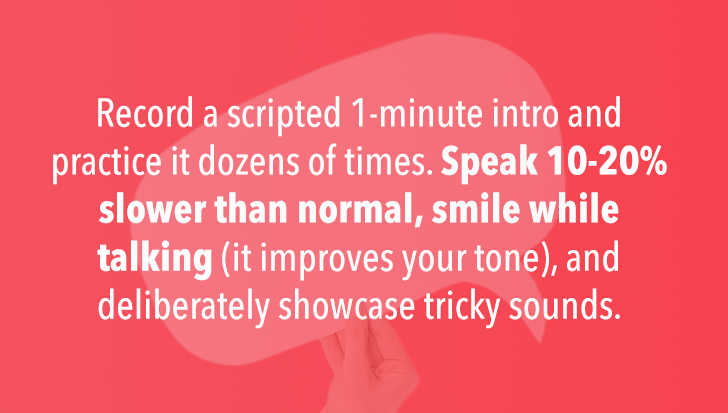
Use every interview, intro video, and demo class to put your practice to work. Here's how to shine:
Nail the Intro Video
Record a scripted 1-minute intro and practice it dozens of times. Speak 10-20% slower than normal, smile while talking (it improves your tone), and deliberately showcase tricky sounds. Include phrases like "I'm Riley, an English teacher from Brazil" to demonstrate clear ISH and Z sounds.
Demo Lesson Success
Use mock lessons to prove your clarity.
- Exaggerate Mouth Shapes: Teaching “THREE”? Stick that tongue out on camera —students rely on visual cues.
- Keep the Pitch Playful: Your intonation practice should sparkle—kids tune in to melody.
- TPR Everything: Point, gesture, thumbs-up.
Confidence Strategies
- Prepare Teacher Phrases: “Alright, let’s get started!” “Great job!” — perfect every consonant.
- Warm Up Beforehand: Quick mouth exercises and shadowing to get in "neutral mode".
- Complete Sentence Rule: Don’t fade at the end; keep volume to the last word.
- Frame Your Background Positively: "As a bilingual speaker, I understand learners' challenges and speak slowly and clearly"
Your Next Move
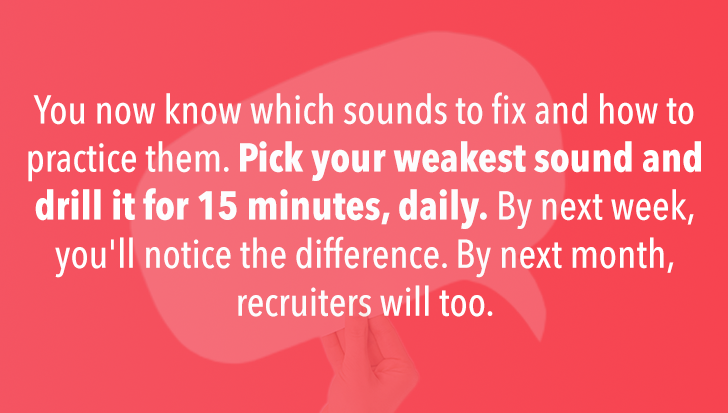
You now know which sounds to fix and how to practice them. Pick your weakest sound and drill it for 15 minutes, daily. By next week, you'll notice the difference. By next month, recruiters will too. Soon any first grader in Beijing, Berlin, or Bogotá can track every phonics sound you teach.
